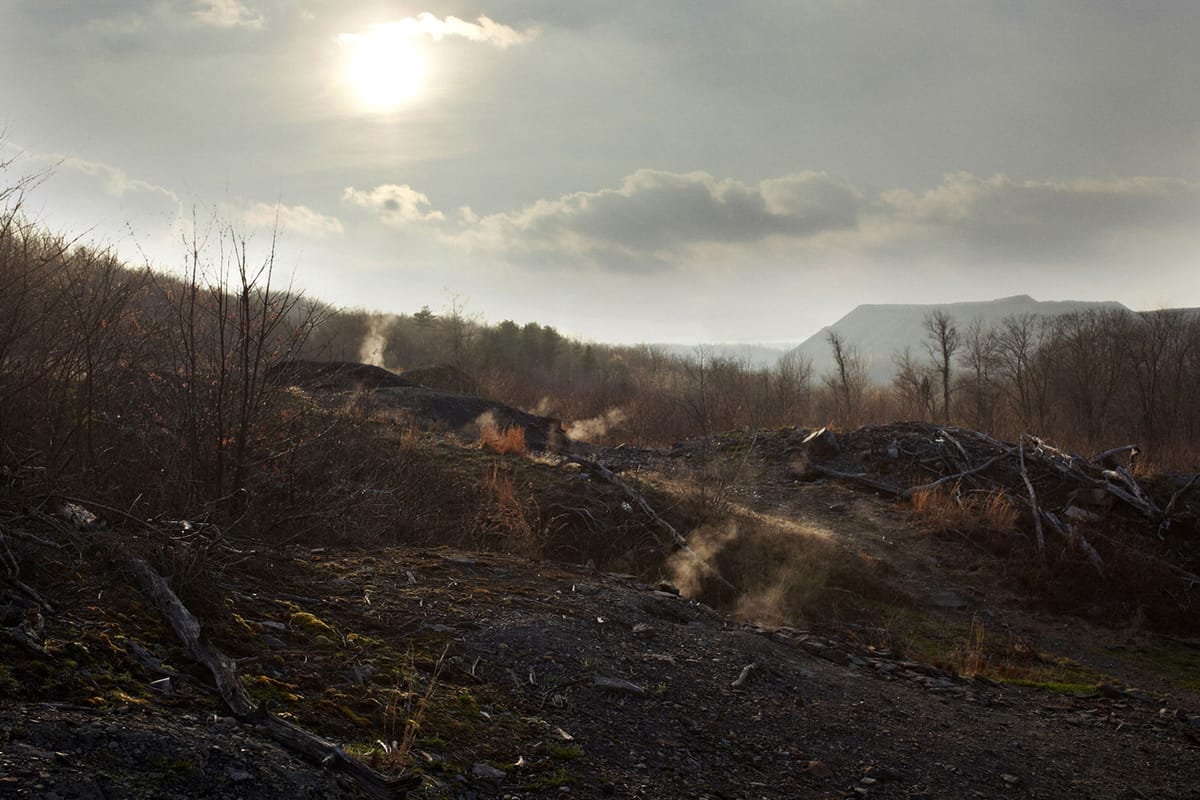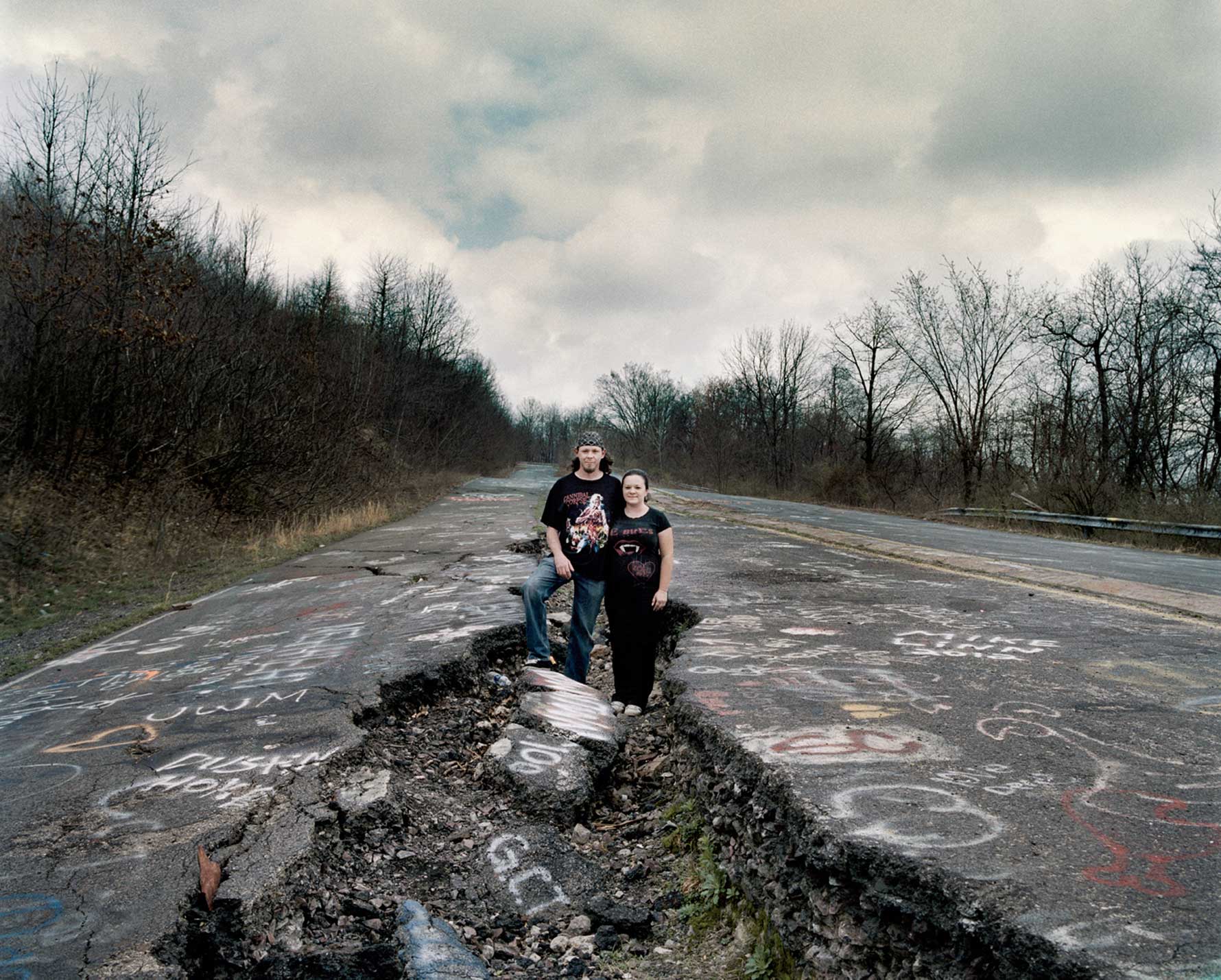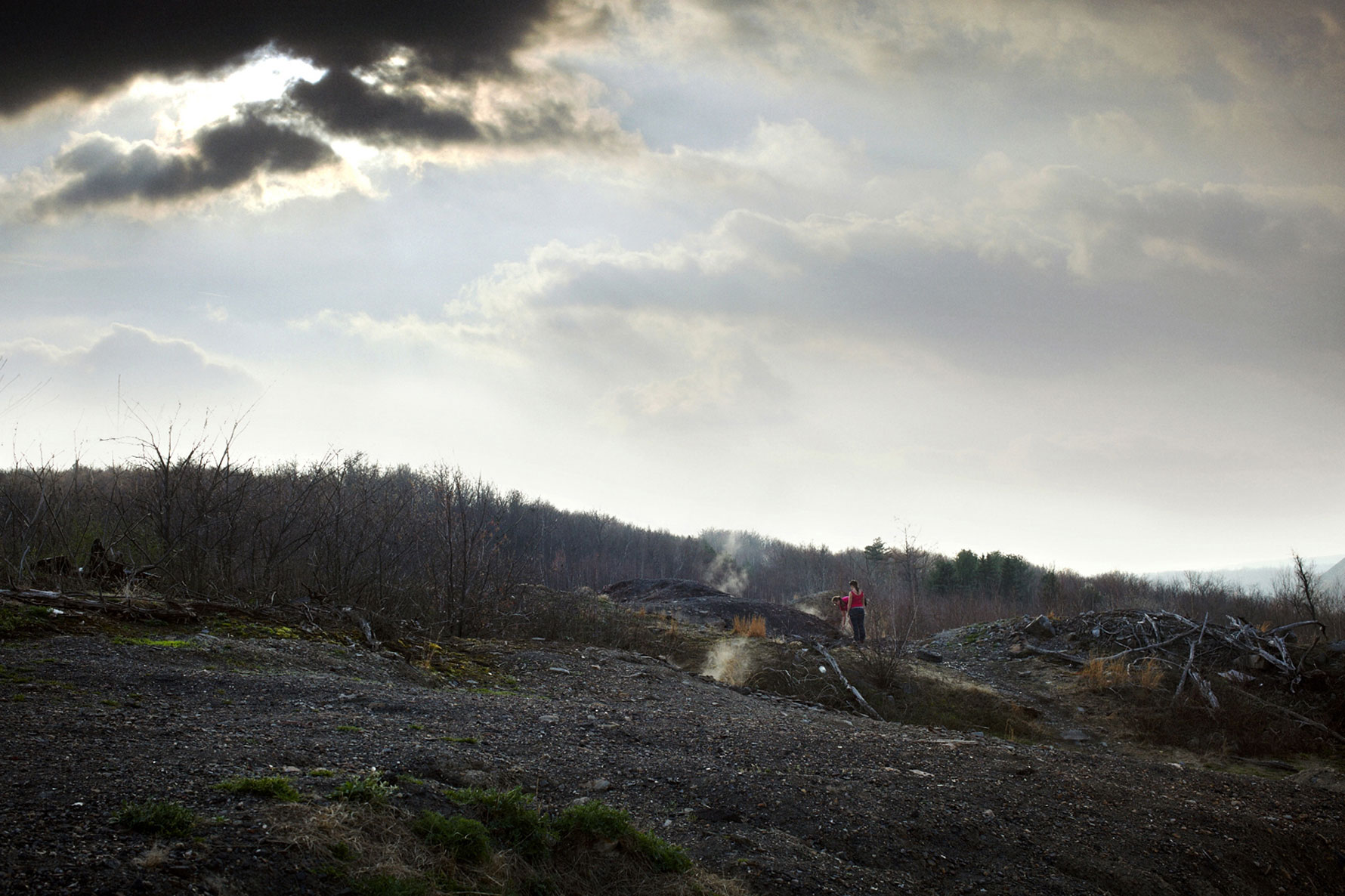When the Town Stops Burning
For 50 years, a fire has been raging in mining tunnels beneath Centralia, Pa. With the town mostly evacuated long ago, what’s left? Mostly journalists and other outsiders looking in.

When I got to the top of the hill that overlooks Centralia, Pa., I could see I was in trouble.
In the trash-strewn foreground there were a few forearm-size holes that faintly puffed sulfurous smoke. On the far side of the cemetery, there was a half-mile stretch of abandoned highway. Down in the valley, where the town used to be, a handful of building-less streets marked off an empty grid, punctuated by a few incongruous stop signs, and three run-down homes that belonged to the holdouts, who still hadn’t left. Sure, it looked spooky, but I needed spectacular.
There was nothing in the landscape that told the story I’d come to tell. Nothing that captured the 50-year-old coal fire raging in mine tunnels beneath Centralia, or the $42 million government buyout that relocated most of the town’s inhabitants. There was nothing that illustrated the eminent domain claim that allowed every building to be condemned and nothing that hinted at the bulldozers that flatten houses and whisk away the scraps whenever one of the remaining residents dies.
The only clues to that history were the tourists and a plywood sign with the word “FIRE” painted on it, pointing to the top of the hill where I was standing. Those wouldn’t satisfy the editor I’d convinced to send me to Centralia. I’d promised him a photo-heavy story about a town on fire. What I found was a smoking hummock and a lot of emptiness.
I first learned about Centralia from my friend Ali. He told me there was an abandoned town in eastern Pennsylvania’s coal country that had been on fire since 1962. A controlled burn at the dump, he said, had somehow reached a coal seam beneath it, and the fire spread. Now it’s big—400 acres—and hotter than 1,000 degrees, eating away at the ground beneath the ground. He told me about sinkholes that had swallowed people, and huge cracks in the earth, and poisonous gases that seeped into buildings.
All that is true. It’s a version of Centralia in a short paragraph. The real story, of course, has unfolded slowly, mostly out of sight, underground, illuminated when the surface gives way, but usually hidden. Such is the nature of geologic events, even the manmade variety.
That’s not to say Centralia has avoided the national spotlight. On Feb. 14, 1981, a 12-year-old boy was swallowed by his grandmother’s backyard, first to his knees, then to his hips, and then to roughly six feet below ground level, where he managed to stop his slow slide through steam-warmed mud. If another child hadn’t been there to reach in and hoist him out, he’d have died in the carbon-monoxide-rich plume of smoke that erupted from the hole, so thick and tall that drivers on the interstate four miles away could see it.
A month later, the town’s former mayor collapsed in an apartment above the shuttered gas station he once operated and still owned. He’d been overcome by fumes that found their way from hundreds of feet below ground, around a vent pipe on the corner of the building, and up, up into his second-story home. When the EMTs carried him out, the whole town knew why. By the time he returned from the hospital, most of his neighbors had accepted that something dangerous was happening beneath them.
Those first few months of 1981 brought statewide attention, and that brought Time and the New York Times Magazine and TV stations and even People. And they all did stories about the town on fire.
In the past 30 years, that story has been done many more times. David DeKok did it for a decade as a local reporter, and then in a book-length expose called Unseen Danger: A Tragedy of People, Government, and the Centralia Mine. Joan Quigley, a granddaughter of Centralia miners, did it in The Day the Earth Caved In: An American Mining Tragedy. The Pittsburgh Post-Gazette did it, and the Philadelphia Inquirer did it, and the Huffington Post did it, and Atlas Obscura did it, too. Of course, there was always more to it than a town on fire—the stubborn elderly resident, the conflicted bureaucrat, the scientist searching for a way to make it stop—but the fire was the juicy bit, so it almost always appeared at the top.
When I visited Centralia on a Thursday in March, six groups of people were walking around. There was a couple who’d come on a Harley Davidson motorcycle, a pack of kids with a video camera and a white sedan, a mother and daughter in matching pink shirts, an old guy in a beat-up pickup with West Virginia plates, three Goth twentysomethings who’d driven from Philly, and Emory and Jessica, whom I walked around with for about an hour. They live in Shenandoah (“Shendoh,” if you’re local), which is a few towns east, about 15 minutes by car.
Jessica, who looks and moves like an angsty teenager but tells the stories of a grown woman, grew up nearby. But she hadn’t visited Centralia until she started dating Emory. He moved to the area in 1999 to marry a woman he met online. “I knew about the fire before I came,” he told me, lifting his long brown hair off his Cannibal Corpse T-shirt and tucking it into his baseball cap. “I’m from New Mexico,” he explained as we walked down the stretch of abandoned highway. “There’s lots of stuff like this, so I keep an eye out.”

Emory and his wife divorced in 2007, and he started dating Jessica a few years later. They went up to the top of the hill early in their courtship, and now it’s a thing. “We’re here all the time,” Jessica said. “11, 12, 2 a.m. We take a blanket and watch the stars.”
We reached a section of roadway spray painted with hundreds of penis silhouettes. The submarine-shaped line drawings stretched across two lanes and ran for about sixty feet. At the end, someone had scrawled “Wiener Farm.” Jessica laughed.
“We were up here with my daughter and his kids. They’re nine and seven, and the little one asked, ‘Why would somebody paint all of these bones?’ My daughter—she’s 17—she nearly died. All of us were laughing.”
I laughed too, as I surveyed a sea of dick doodles and thought about the story I’d promised to write.
In 1984, the U.S. Congress allocated more than $42 million to relocate Centralia’s 1,000 residents. There were lots of generous buyouts. If you ask around in neighboring towns, you’ll still hear some jealousy.
“I don’t know why people are still up there,” said Afternoon Vickie, a waitress at Mattucci’s in Mount Carmel (where there’s also a Vickie who works at night). “The smart ones got rich and got out, and now it’s just the stubborn ones left.”
Thick deciduous forest and rolling hills that ramp into broad 1,600-foot summits steep enough to occasionally cliff out and offer unobstructed views of the Susquehanna River.
Fifty-three homeowners did not accept the first offer. They stayed and watched as their neighbors slowly disappeared, and the abandoned houses were taken down, and weeds grew up, and they talked up an alternate theory. Mineral rights: That’s what it was really about. Centralia sits atop 25 million tons of the highest quality coal in America. Its market value might exceed one billion dollars. The state of Pennsylvania wanted what was underneath the town, and they had exaggerated the dangers that faced residents in order to drive them out, or so the holdouts hypothesized.
In 1992, Pennsylvania Gov. Bob Casey used eminent domain to seize all of Centralia and pressure the remaining residents to leave. That sparked lawsuits and another batch of news stories. In 2002, five years after the local post office was demolished, the U.S. Postal Service revoked the town’s ZIP code. From then on, mail sent to “Centralia, PA 17927” would be returned to sender. The last few inhabitants could still receive correspondence sent to “Ashland, PA 17921,” but they all knew that wasn’t where they lived. Finally, in June of 2009, the formal evictions started. The population of the place that remains is nine.
Thousands visit Centralia every year. There isn’t a tourism board that keeps track of the numbers, but I saw more than a dozen people on a Thursday in March, which means a whole lot more would be around on a Saturday in June.
It’s easy enough to get there: three hours driving from New York City, two from Philadelphia, one from Harrisburg. The country is northern Appalachia at is finest. Thick deciduous forest and rolling hills that ramp into broad 1,600-foot summits steep enough to occasionally cliff out and offer unobstructed views of the Susquehanna River and the smaller creeks that piece together the landscape like burbling mortar.
Knoebels is nearby. I promised Afternoon Vickie that I’d mention Knoebels. It’s America’s largest free-admission amusement park, and it’s right around the corner from Centralia. I didn’t get a chance to visit or ride the rides—it doesn’t open for the season until April 28—but there is a wooden roller coaster and a log flume and a three-story haunted mine tour called Black Diamond. About 1.3 million people visit Knoebels each year. Afternoon Vickie told me that it is a lot more fun than Centralia.
Everyone knew I was a reporter. Before I told them, before I pulled the spiral-bound pad from the back pocket of my jeans, they knew. They’re used to reporters. Emory and Jessica said journalists are up on the hill interviewing folks all the time. When Afternoon Vickie asked me who I worked for and I told her lots of places, she shot me a look and said, “Freelance?” like she knew the drill.
The locals I spoke with, even the ones that seemed sick of talking about Centralia, were boisterous about the town’s curiosities. Everyone wanted to tell me about the best spots to see sinkholes and everyone assured me it looked more intense in the rain, when the steam made the smoke thick. One woman told me about a place where you can see blue flames coming out of the ground, but when I asked other people about that they said it wasn’t true.
One woman told me about a place where you can see blue flames coming out of the ground, but when I asked other people about that they said it wasn’t true.
After talking with Emory and Jessica for a while, I confessed to them that I thought Centralia was going to look more dramatic. “You read about a town with a fire beneath it, and you picture something like hell.”
Jessica said that when Emory took her up there the first time, she was scared by what she’d heard, but he packed sandwiches and that made her feel better. She still doesn’t get as close to the holes as he does, though. He likes to find big sticks—a few feet long and a couple inches wide—and jam them down into the smoking openings that pimple the hill. They come out black and wet and the smoke thickens and he smiles.
Emory told me there were hundreds of other coal fires in the U.S. and a handful more in Pennsylvania. I nodded and said, “Really?” so he’d keep talking, but I didn’t believe him. Turns out, he’s right. The Office of Surface Mining has identified 100 fires burning beneath nine states. There are 45 just in Pennsylvania, though none are as famous as the one in Centralia.
On the drive home, I knew I was going to have to tell that editor I didn’t get what he wanted. There wasn’t a town on fire in Centralia, or a snippet of the American bizarre, or a parable of disaster. Sure, it was spooky, but it wasn’t spectacular. It was friendly people making the most of a fucked-up history. It was tourists chasing something out of sight. It was stories about kids and a good lunch with a pint of Yuengling and a glowing recommendation of Knoebels, which also has a water park.
When I got back to my apartment, I emailed the editor. I told him that I didn’t get enough to do the story, and that he should find something else to fill the hole. I apologized and explained myself and tried to salvage a sliver of my credibility.
And then I pitched him an idea: “There’s a time capsule buried in Centralia,” I wrote. “It was put in the ground in 1966, before anyone got sick or lost their home or even understood what the mine fire would do to the town. They’re going to dig it up in 2016, and I’d like to be there. I’d like to do a story about Centralia filled with people.”

